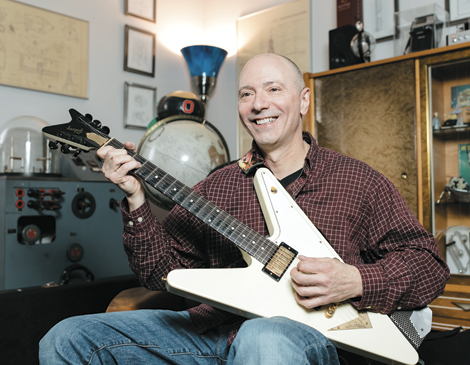
Rock Hard Picks Are Made From Fighter Jet Materials
He’s also a rocker — a shredder, he would say. The guitarist of classic rock cover band 80-HD, Mearini, a player for 43 years, was accepted to the prestigious Berklee College of Music at 18 years old. Just days before heading to school, however, he had an epiphany. I think I want to get a Ph.D in physics instead.
“My father was like, Give me a break,” says Mearini, whose 10 years of college included undergrad at Ohio State University and doctoral studies at Case Western Reserve University. “He teased me until I was in grad school.”
But more than 30 years later, Mearini has overdubbed his physics mastery with his passion for the guitar. From his Genvac Aerospace laboratory, he launched Rock Hard Picks in 2016. The company’s metal guitar picks are coated with the same diamond-like carbon used on military aircraft. The nearly frictionless material creates a lightning-fast picking experience and amplifies the strings.
Diamond-like carbon carries the same molecular bonds as crystalline diamond, but is grown in a vacuum system through a process called chemical vapor deposition. Instead of growing in a crystal or even starting as a solid, the material is created by pressurizing pure methane gas. Diamond-like carbon is an ideal coating due to its amorphous, conformal nature. As a cover for fighter jet optical lenses, it prevents scratching in sandstorms, for example, when planes travel at speeds of Mach 2. It’s also used to reduce friction-loss on NASCAR engines, extend the lifespan of artificial knees and make the Space Black Apple Watch look cool.
Five years ago, Mearini, tired of worn-out, flimsy nylon picks, decided to create stainless steel picks. They were great, he says, but the sharp edge broke strings almost daily.
“I thought, We’re one of three companies in the world that can produce this amazing coating,” he says. “Let’s put it on guitar picks.”
From four-by-eight-foot sheets of stainless steel, Mearini cuts about 1,600 picks. After being electro-polished for smoothness, they’re placed inside a vacuum, where pure methane gas is stirred up, creating plasma that attracts to an electrode underneath the picks. As they’re coated, a chemical reaction gives off a purple glow. The result is a dense, unable-to-be-scratched coating.
An excited Mearini shared his new invention with guitar techs for Eddie Van Halen and Dave Grohl. Both players turned it down. Then a mutual friend gave one to Tony Artino, a performing guitarist and former session player with credits on songs from Eddie Money and members of Heart.
“Tony contacted me two days later and said, ‘This is a great concept, but this edge is horrible. I’m gonna fix it,’ ” says Mearini.
The collaboration recreates that sweet-spot wear that a plastic pick gets after a day of playing but then never has again. Now, specific picks for lefties and righties feature beveled leading edges for the down stroke and a “worn” upper edge for the upstroke. For the final step, the Rock Hard logo and “Made In Cleveland” is laser engraved onto each one by Universal Grinding on West 78th Street.
At $20, it’s a big ask for guitarists used to paying 45 cents for a plastic pick. But the picks show little wear after more than a year of heavy playing. Guitarists are also notorious for losing picks, so each one comes with a necklace and a clasp to always keep the fancy plectrum on-hand.
“These are the Porsche of guitar picks,” says Artino. “When you spend $100 on sunglasses, you always know where they are.” Mearini and Artino think picks are the tip of the diamond-like carbon iceberg. They’re already building slides and pick guards, and have their sights set on bridges and saddles that minimize string breakage.
“This is one of the first truly scientific approaches to fixing some of these issues,” Mearini says. “Marrying NASA-level technology and [musical expertise] is going to take the music product world by storm.”
in the cle
8:00 AM EST
May 22, 2019



